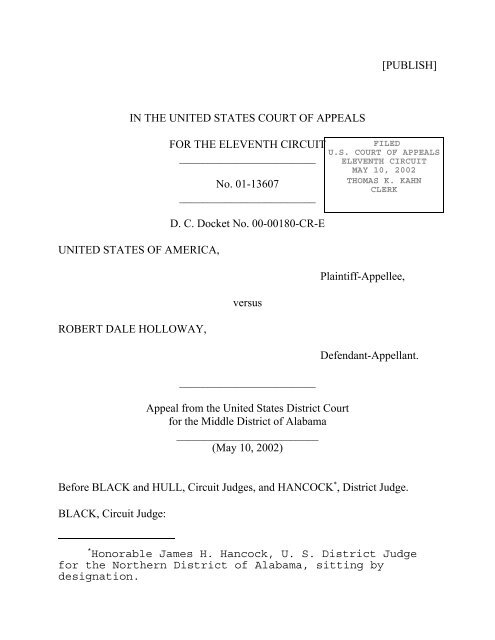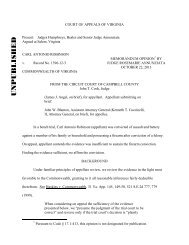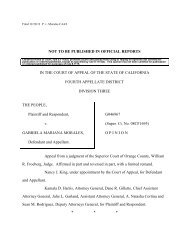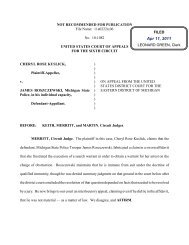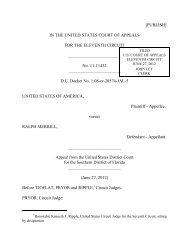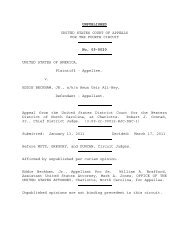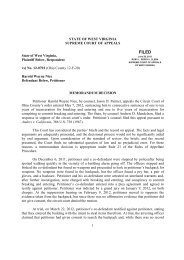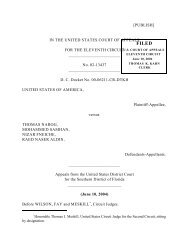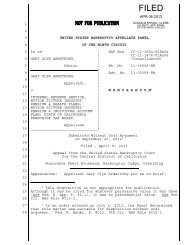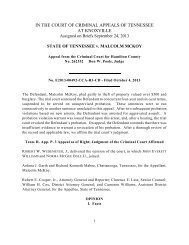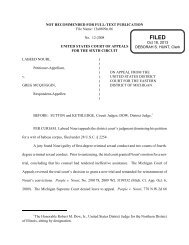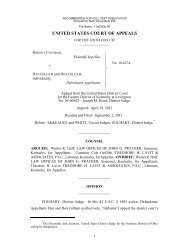USA v. Robert Dale Holloway - Court of Appeals - 11th Circuit
USA v. Robert Dale Holloway - Court of Appeals - 11th Circuit
USA v. Robert Dale Holloway - Court of Appeals - 11th Circuit
You also want an ePaper? Increase the reach of your titles
YUMPU automatically turns print PDFs into web optimized ePapers that Google loves.
[PUBLISH]<br />
IN THE UNITED STATES COURT OF APPEALS<br />
UNITED STATES OF AMERICA,<br />
ROBERT DALE HOLLOWAY,<br />
FOR THE ELEVENTH CIRCUIT<br />
________________________<br />
No. 01-13607<br />
________________________<br />
D. C. Docket No. 00-00180-CR-E<br />
versus<br />
________________________<br />
Appeal from the United States District <strong>Court</strong><br />
for the Middle District <strong>of</strong> Alabama<br />
_________________________<br />
(May 10, 2002)<br />
FILED<br />
U.S. COURT OF APPEALS<br />
ELEVENTH CIRCUIT<br />
MAY 10, 2002<br />
THOMAS K. KAHN<br />
CLERK<br />
Plaintiff-Appellee,<br />
Defendant-Appellant.<br />
Before BLACK and HULL, <strong>Circuit</strong> Judges, and HANCOCK * , District Judge.<br />
BLACK, <strong>Circuit</strong> Judge:<br />
* Honorable James H. Hancock, U. S. District Judge<br />
for the Northern District <strong>of</strong> Alabama, sitting by<br />
designation.
This case arises from a 911 call reporting gunshots and arguing originating<br />
from Appellant <strong>Robert</strong> <strong>Dale</strong> <strong>Holloway</strong>’s residence. Investigating the emergency<br />
call, law enforcement <strong>of</strong>ficers conducted a warrantless search <strong>of</strong> the residence.<br />
Although no victims were found by the <strong>of</strong>ficers, the search uncovered the firearm<br />
used to cause the disturbance. Appellant subsequently was indicted and convicted<br />
for unlawful possession <strong>of</strong> a firearm by a felon. On appeal, he argues the firearm<br />
and other evidence seized by the <strong>of</strong>ficers should have been suppressed as fruits <strong>of</strong><br />
an unconstitutional search. Upon review <strong>of</strong> the record, we conclude the district<br />
court did not err in denying Appellant’s motion to suppress and affirm.<br />
I. BACKGROUND<br />
At 10:22 p.m. on August 4, 1999, Officer Norman Bernard <strong>of</strong> the Alexander<br />
City Police Department received a dispatch from a 911 operator to investigate a<br />
report <strong>of</strong> gunshots and arguing emanating from 3785 Washington Street. Officer<br />
Bernard proceeded immediately to the location <strong>of</strong> the disturbance. En route, the<br />
<strong>of</strong>ficer received a second dispatch from the 911 operator indicating the caller was<br />
reporting continued gunshots and arguing. Officer Bernard arrived at the<br />
designated address at approximately 10:29 p.m., within a minute <strong>of</strong> the second<br />
dispatch from the emergency operator. Providing back-up in a separate patrol car<br />
was Officer Marcus Billips, who also responded to the emergency dispatch.<br />
2
Upon arrival, Officer Bernard pulled into the driveway <strong>of</strong> the residence<br />
located at 3785 Washington Street, a mobile home occupied by Appellant. The<br />
<strong>of</strong>ficer illuminated the residence with his headlights and spotlight. On the porch <strong>of</strong><br />
the residence were Appellant and his wife, Lena <strong>Holloway</strong>. Due to the high-risk<br />
nature <strong>of</strong> the 911 call, Officer Bernard drew his service weapon as he exited his<br />
vehicle. From behind his car door, Officer Bernard instructed Appellant and his<br />
wife to raise their hands into view. Appellant complied; his wife did not. As<br />
directed, Appellant stepped <strong>of</strong>f the porch and walked towards Officer Bernard and<br />
Officer Billips. As Appellant proceeded towards the <strong>of</strong>ficers, a third individual,<br />
later identified as neighbor Mike Machado, emerged from behind a horse trailer<br />
parked in the yard. The neighbor also was ordered to raise his hands and walk<br />
towards the <strong>of</strong>ficers. Both Appellant and his neighbor were instructed to lie on the<br />
ground facing away from the <strong>of</strong>ficers, their palms facing up.<br />
Although the two men were compliant, Mrs. <strong>Holloway</strong> refused to leave the<br />
porch, and instead sat down on a chair. Despite several verbal commands, Mrs.<br />
<strong>Holloway</strong> refused to move. Suddenly, a child appeared in the doorway <strong>of</strong> the<br />
residence. The child was ordered back into the house. Ultimately, because <strong>of</strong><br />
Mrs. <strong>Holloway</strong>’s unresponsiveness, Officer Bernard threatened to employ his<br />
pepper spray. Finally, with encouragement from Appellant, Mrs. <strong>Holloway</strong> stepped<br />
3
<strong>of</strong>f the porch, but refused to raise her hands. By this time, Sergeant Randy Walters,<br />
who had arrived on the scene to provide additional support, stepped in to secure<br />
Mrs. <strong>Holloway</strong>.<br />
After Mrs. <strong>Holloway</strong> was placed under control, Officer Bernard turned his<br />
attention to Appellant. The <strong>of</strong>ficer handcuffed Appellant and quickly patted him<br />
down to see if he was concealing a weapon. Officer Billips then engaged in the<br />
same procedure with respect to Mr. Machado. Once they were secured, the two<br />
men were placed separately in the <strong>of</strong>ficers’ patrol cars. Altogether, approximately<br />
ten minutes elapsed from the time the <strong>of</strong>ficers arrived on the scene to the time<br />
those present were secured.<br />
Having placed Appellant safely into his patrol car, Officer Bernard<br />
approached the residence to check for victims and weapons on the premises. In<br />
doing so, the <strong>of</strong>ficer observed several beer cans strewn about the yard and porch.<br />
As he stepped onto the porch, Officer Bernard saw a shotgun shell on top <strong>of</strong> the<br />
picnic table. Glancing around for a corresponding weapon, the <strong>of</strong>ficer located a<br />
model 870 Remington shotgun leaning against the side <strong>of</strong> the mobile home,<br />
approximately three feet from where Appellant had been standing when the<br />
<strong>of</strong>ficers first arrived. The safety was disengaged. Additional shotgun shells, two<br />
expended and one live, were found lying in the grass by the side <strong>of</strong> the residence.<br />
4
Officer Bernard locked the weapon in the trunk <strong>of</strong> his patrol car and returned to the<br />
house to continue his search for victims and investigate the disturbance. No victims<br />
were found.<br />
After ensuring that everyone on the scene was safe, Officer Bernard<br />
approached Appellant to inform him <strong>of</strong> the 911 call and to explain the <strong>of</strong>ficers’<br />
reasons for securing those present on the premises. As Officer Bernard was<br />
explaining the <strong>of</strong>ficers’ actions, Appellant interrupted to describe what had<br />
transpired earlier that evening. According to Appellant, the commotion began<br />
when three males standing on the railroad tracks behind Appellant’s mobile home<br />
started throwing rocks at his house and horses. In an effort to ward <strong>of</strong>f the men,<br />
Appellant fired his shotgun into the air above the railroad tracks.<br />
In light <strong>of</strong> his conversation with Appellant, Officer Bernard left to speak<br />
with Sergeant Walters. According to Sergeant Walters, Appellant’s account <strong>of</strong> the<br />
evening’s events matched an account given by Mrs. <strong>Holloway</strong>. Based on this<br />
information, Sergeant Walters determined there was sufficient cause to arrest<br />
Appellant. 1<br />
Appellant was then placed under arrest by Officer Bernard at<br />
approximately 11:05 p.m., 36 minutes after the <strong>of</strong>ficers first arrived on the scene.<br />
1 Although it is not clear from the record, the<br />
Government stated at oral argument that Appellant was<br />
arrested for reckless endangerment and disorderly<br />
conduct.<br />
5
Following his arrest, Appellant was indicted by a federal grand jury for<br />
possession <strong>of</strong> a firearm by a convicted felon, in violation <strong>of</strong> 18 U.S.C. § 922(g). 2<br />
The firearm at issue was the model 870 Remington shotgun discovered by Officer<br />
Bernard at Appellant’s residence on August 4, 1999. Claiming the search <strong>of</strong> his<br />
home violated the Fourth Amendment, Appellant moved the district court to<br />
suppress the firearm and any other evidence seized by Officer Bernard.<br />
Appellant’s motion to suppress was denied. Thereafter, Appellant pled guilty,<br />
preserving the right to appeal the denial <strong>of</strong> his motion to suppress. This appeal<br />
followed. 3<br />
2 Appellant was convicted <strong>of</strong> first degree assault on<br />
August 11, 1983.<br />
3 In addition to appealing the denial <strong>of</strong> his motion<br />
to suppress the firearm and other evidence seized by<br />
Officer Bernard, Appellant also appeals the district<br />
court’s denial <strong>of</strong> his motion to suppress incriminating<br />
statements made to Officer Bernard concerning the<br />
events <strong>of</strong> August 4, 1999. He argues these statements<br />
were made in violation <strong>of</strong> the Fifth Amendment and<br />
Miranda v. Arizona, 384 U.S. 436, 86 S. Ct. 1602<br />
(1966). Having considered Appellant’s arguments as to<br />
this issue in light <strong>of</strong> the record, we affirm without<br />
discussion the district court’s denial <strong>of</strong> his motion to<br />
suppress statements. See <strong>11th</strong> Cir. R. 36-1.<br />
6
II. STANDARD OF REVIEW<br />
Review <strong>of</strong> a district court’s denial <strong>of</strong> a motion to suppress evidence is a<br />
mixed question <strong>of</strong> law and fact. United States v. Alexander, 835 F.2d 1406, 1408<br />
(<strong>11th</strong> Cir. 1988). The district court’s findings <strong>of</strong> fact are reviewed under the<br />
clearly erroneous standard, whereas its application <strong>of</strong> the law is subject to de novo<br />
review. Id. In reviewing the district court’s ruling, this <strong>Court</strong> must construe the<br />
facts in the light most favorable to the party prevailing below, which, in this case,<br />
is the Government. United States v. Wilson, 894 F.2d 1245, 1254 (<strong>11th</strong> Cir. 1990).<br />
III. DISCUSSION<br />
This case presents an issue <strong>of</strong> first impression to this <strong>Circuit</strong> concerning<br />
whether law enforcement <strong>of</strong>ficials may conduct a warrantless search <strong>of</strong> a private<br />
residence in response to an emergency situation reported by an anonymous 911<br />
caller. We conclude that when exigent circumstances demand an immediate<br />
response, particularly where there is danger to human life, protection <strong>of</strong> the public<br />
becomes paramount and can justify a limited, warrantless intrusion into the home.<br />
Once in the home, <strong>of</strong>ficers may seize any evidence found within plain view.<br />
A. Warrantless Search <strong>of</strong> Appellant’s Residence<br />
The Fourth Amendment to the Constitution <strong>of</strong> the United States sets forth a<br />
general proscription on warrantless searches <strong>of</strong> a person’s home: “The right <strong>of</strong> the<br />
7
people to be secure in their persons, houses, papers, and effects, against<br />
unreasonable searches and seizures, shall not be violated . . . .” U.S. Const. amend.<br />
IV. The Fourth Amendment’s prohibition <strong>of</strong> warrantless searches, however, is not<br />
absolute. Although there is a strong preference for searches and entries conducted<br />
under the judicial auspices <strong>of</strong> a warrant, the United States Supreme <strong>Court</strong> has<br />
crafted a few carefully drawn exceptions to the warrant requirement to cover<br />
situations where “the public interest require[s] some flexibility in the application <strong>of</strong><br />
the general rule that a valid warrant is a prerequisite for a search.” Arkansas v.<br />
Sanders, 442 U.S. 753, 759, 99 S. Ct. 2586, 2590 (1979). One such exception is<br />
that the police may enter a private premises and conduct a search if “exigent<br />
circumstances” mandate immediate action. See Michigan v. Tyler, 436 U.S. 499,<br />
509, 98 S. Ct. 1942, 1949-50 (1978).<br />
The exigent circumstances exception recognizes a “warrantless entry by<br />
criminal law enforcement <strong>of</strong>ficials may be legal when there is compelling need for<br />
<strong>of</strong>ficial action and no time to secure a warrant.” Michigan, 436 U.S. at 509, 98 S.<br />
Ct. at 1949. The exception encompasses several common situations where resort<br />
to a magistrate for a search warrant is not feasible or advisable, including: danger<br />
<strong>of</strong> flight or escape, loss or destruction <strong>of</strong> evidence, risk <strong>of</strong> harm to the public or the<br />
police, mobility <strong>of</strong> a vehicle, and hot pursuit. See Johnson v. United States, 333<br />
8
U.S. 10, 14-15, 68 S. Ct. 367, 369 (1948) (listing situations falling within exigent<br />
circumstances exception); see also United States v. Reid, 69 F.3d 1109, 1113-14<br />
(<strong>11th</strong> Cir. 1995) (upholding warrantless search <strong>of</strong> residence based on exigent<br />
circumstances arising from risk <strong>of</strong> losing evidence, risk <strong>of</strong> flight, and danger <strong>of</strong><br />
harm to public or <strong>of</strong>ficers); United States v. Forker, 928 F.2d 365, 368-69 (<strong>11th</strong><br />
Cir. 1991) (upholding warrantless search <strong>of</strong> vehicle based on mobility); United<br />
States v. Tobin, 923 F.2d 1506, 1510-11 (<strong>11th</strong> Cir. 1991) (en banc) (upholding<br />
warrantless search <strong>of</strong> residence based on danger narcotics would be destroyed or<br />
removed); United States v. Burgos, 720 F.2d 1520, 1525-26 (<strong>11th</strong> Cir. 1983)<br />
(upholding warrantless search <strong>of</strong> residence based on threat <strong>of</strong> injury to<br />
neighborhood arising from defendant’s stash <strong>of</strong> weapons); United States v. Blasco,<br />
702 F.2d 1315, 1326 (<strong>11th</strong> Cir. 1983) (upholding warrantless search based on<br />
imminent danger <strong>of</strong> flight or escape); United States v. Kreimes, 649 F.2d 1185,<br />
1192 (5th Cir. Unit B 1981) (upholding warrantless search based on hot pursuit<br />
and danger posited by possibility <strong>of</strong> armed fugitive remaining at large). 4<br />
4 In Bonner v. City <strong>of</strong> Prichard, 661 F.2d 1206, 1209<br />
(<strong>11th</strong> Cir. 1981) (en banc), this <strong>Court</strong> adopted as<br />
binding precedent all decisions <strong>of</strong> the former Fifth<br />
<strong>Circuit</strong> handed down prior to close <strong>of</strong> business on<br />
September 30, 1981.<br />
9
One <strong>of</strong> the most compelling events giving rise to exigent circumstances is<br />
the occurrence <strong>of</strong> an emergency situation. The Supreme <strong>Court</strong> has long recognized<br />
that emergencies sometimes obviate the need to obtain a search warrant prior to<br />
entering a private residence. See, e.g., Michigan, 436 U.S. at 509, 98 S. Ct. at 1950<br />
(“A burning building clearly presents an exigency <strong>of</strong> sufficient proportions to<br />
render a warrantless entry ‘reasonable.’ Indeed, it would defy reason to suppose<br />
that firemen must secure a warrant or consent before entering a burning structure to<br />
put out the blaze.”); Vale v. Louisiana, 399 U.S. 30, 35, 90 S. Ct. 1969, 1972<br />
(1970) (noting warrantless search could not be justified based on exigent<br />
circumstances, where police <strong>of</strong>ficers were not responding to an emergency);<br />
McDonald v. United States, 335 U.S. 451, 454, 69 S. Ct. 191, 193 (1948) (“Where,<br />
as here, <strong>of</strong>ficers are not responding to an emergency, there must be compelling<br />
reasons to justify the absence <strong>of</strong> a search warrant.”).<br />
The most urgent emergency situation excusing police compliance with the<br />
warrant requirement is, <strong>of</strong> course, the need to protect or preserve life. Mincey v.<br />
Arizona, 437 U.S. 385, 392, 98 S. Ct. 2408, 2413 (1978). In Mincey, an<br />
undercover police <strong>of</strong>ficer who had arranged a narcotics transaction with the<br />
defendant arrived at the defendant’s apartment with several other <strong>of</strong>ficers. Id. at<br />
387, 98 S. Ct. at 2410-11. When the door to the apartment was opened in response<br />
10
to his knocks, the undercover <strong>of</strong>ficer slipped inside and moved quickly into the<br />
bedroom. Id., 98 S. Ct. at 2411. As the other <strong>of</strong>ficers entered the apartment, they<br />
heard a volley <strong>of</strong> gunshots emanating from the bedroom. Id., 98 S. Ct. at 2411.<br />
The undercover <strong>of</strong>ficer emerged from the bedroom and collapsed on the floor. Id.,<br />
98 S. Ct. at 2411. The other <strong>of</strong>ficers then entered the bedroom, where they found<br />
the defendant lying on the floor, wounded and semiconscious. Id., 98 S. Ct. at<br />
2411. A search for victims revealed an injured woman in the closet and three<br />
accomplices, one <strong>of</strong> whom was wounded in the head. Id. at 388, 98 S. Ct. at 2411.<br />
After the scene was secured, homicide detectives arrived at the apartment to search<br />
for evidence. Id. at 388-89, 98 S. Ct. at 2411. Although the search lasted four<br />
days, no warrant was ever obtained. Id. at 389, 98 S. Ct. at 2411.<br />
On appeal, the defendant argued the evidence seized during the homicide<br />
detectives’ four-day search <strong>of</strong> his apartment should be suppressed as the product <strong>of</strong><br />
an unlawful warrantless search. 437 U.S. at 388, 98 S. Ct. at 2411. The Supreme<br />
<strong>Court</strong> agreed, holding there is no general “murder scene” exception to the Fourth<br />
Amendment. Id. at 395, 98 S. Ct. at 2415. Although the four-day search <strong>of</strong> the<br />
defendant’s apartment was unlawful because it was not strictly circumscribed by<br />
the exigencies which justified its initiation, the Supreme <strong>Court</strong> nevertheless<br />
11
endorsed the authority <strong>of</strong> police <strong>of</strong>ficers to make warrantless entries and searches<br />
based on emergency circumstances:<br />
We do not question the right <strong>of</strong> the police to respond to emergency<br />
situations. Numerous state and federal cases have recognized that the<br />
Fourth Amendment does not bar police <strong>of</strong>ficers from making<br />
warrantless entries and searches when they reasonably believe that a<br />
person within is in need <strong>of</strong> immediate aid. Similarly, when the police<br />
come upon the scene <strong>of</strong> a homicide they may make a prompt<br />
warrantless search <strong>of</strong> the area to see if there are other victims or if a<br />
killer is still on the premises. Cf. Michigan v. Tyler, supra, 436 U.S.,<br />
at 509-510, 98 S. Ct. at 1950-1951. “The need to protect or preserve<br />
life or avoid serious injury is justification for what would be otherwise<br />
illegal absent an exigency or emergency.” Wayne v. United States,<br />
115 U.S. App. D.C. 234, 241, 318 F.2d 205, 212 (opinion <strong>of</strong> Burger,<br />
J.).<br />
Id. at 392-93, 98 S. Ct. at 2413.<br />
The Supreme <strong>Court</strong>’s endorsement <strong>of</strong> warrantless searches based on an<br />
endangerment to life also is evident in Warden v. Hayden, 387 U.S. 294, 87 S. Ct.<br />
1642 (1967). In Hayden, two taxi drivers reported seeing an armed robber run into<br />
a residence at 2111 Cocoa Lane. 387 U.S. at 297, 107 S. Ct. at 1645. Within<br />
minutes, police arrived at the house. Id., 107 S. Ct. at 1645. During a search <strong>of</strong> the<br />
premises, the defendant was discovered in an upstairs bedroom and arrested. Id. at<br />
298, 107 S. Ct. at 1645. A shotgun and pistol, located in an adjoining bathroom’s<br />
flush tank, were seized. Id., 107 S. Ct. at 1645. Also seized were a jacket and<br />
12
trousers <strong>of</strong> the type the robber was said to have worn, which were found in the<br />
washing machine. Id., 107 S. Ct. at 1645.<br />
On appeal, the Supreme <strong>Court</strong> considered whether the warrantless search <strong>of</strong><br />
the residence was constitutional. Based on the exigencies <strong>of</strong> the situation, the<br />
<strong>Court</strong> upheld the search:<br />
We agree with the <strong>Court</strong> <strong>of</strong> <strong>Appeals</strong> that neither the entry<br />
without warrant to search for the robber, nor the search for him<br />
without warrant was invalid. Under the circumstances <strong>of</strong> this case,<br />
“the exigencies <strong>of</strong> the situation made that course imperative.”<br />
McDonald v. United States, 335 U.S. 451, 456, 69 S. Ct. 191, 193, 93<br />
L. Ed. 153. . . . The Fourth Amendment does not require police<br />
<strong>of</strong>ficers to delay in the course <strong>of</strong> an investigation if to do so would<br />
gravely endanger their lives or the lives <strong>of</strong> others. Speed here was<br />
essential, and only a thorough search <strong>of</strong> the house for persons and<br />
weapons could have insured that Hayden was the only man present<br />
and that the police had control <strong>of</strong> all weapons which could be used<br />
against them or to effect an escape.<br />
387 U.S. at 298-99, 87 S. Ct. at 1645-46.<br />
Following the reasoning <strong>of</strong> the Supreme <strong>Court</strong>, numerous federal and state<br />
courts have upheld warrantless emergency entries and searches based on<br />
endangerment to life. See, e.g., United States v. Hughes, 993 F.2d 1313 (7th Cir.<br />
1993) (report <strong>of</strong> woman and child in danger in crack house); United States v.<br />
Gillenwaters, 890 F.2d 679 (4th Cir. 1989) (stabbing victim); United States v.<br />
Martin, 781 F.2d 671 (9th Cir. 1985) (explosion in apartment); Mann v. Cannon,<br />
731 F.2d 54 (1st Cir. 1984) (open access to controlled substances by children);<br />
13
United States v. Riccio, 726 F.2d 638 (10th Cir. 1984) (medical aid to defendant<br />
shot by police); United States v. Jones, 635 F.2d 1357 (8th Cir. 1980) (report <strong>of</strong><br />
gunshots); United States v. Barone, 330 F.2d 543 (2d Cir. 1964) (screams in the<br />
night); United States v. Searle, 974 F. Supp. 1433 (M.D. Fla. 1997) (report <strong>of</strong><br />
gunshots); United States v. Herndon, 390 F. Supp. 1017 (S.D. Fla. 1975) (report <strong>of</strong><br />
gunshots); United States v. Hogue, 283 F. Supp. 846 (N.D. Ga. 1968) (report <strong>of</strong><br />
dead body); Johnson v. State, 386 So. 2d 302 (Fla. App. 1980) (report <strong>of</strong> dead<br />
body); State v. Carlson, 548 N.W.2d 138 (Iowa 1996) (missing person); State v.<br />
Butler, 676 S.W.2d 809 (Mo. 1984) (en banc) (gunshot victim); State v. Mackins,<br />
266 S.E.2d 694 (N.C. App. 1980) (gunshots); State v. Max, 263 N.W.2d 685 (S.D.<br />
1978) (gunshots).<br />
Although this <strong>Court</strong> has not directly addressed emergency searches based on<br />
endangerment to life, we have on at least two occasions generally endorsed the<br />
validity <strong>of</strong> such searches. See United States v. Brand, 556 F.2d 1312 (5th Cir.<br />
1977) (noting defendant’s concession that police <strong>of</strong>ficer who assisted ambulance<br />
attendants with medical emergency legally entered home); United States v. Green,<br />
474 F.2d 1385 (5th Cir. 1973) (indicating deputy fire marshal could validly search<br />
apartment to determine cause <strong>of</strong> fire where ascertaining cause was necessary to<br />
assure fire was completely extinguished). Furthermore, upholding warrantless<br />
14
searches in such situations is consistent with our jurisprudence concerning the<br />
exigent circumstances exception.<br />
Based on the foregoing, we conclude emergency situations involving<br />
endangerment to life fall squarely within the exigent circumstances exception. It is<br />
difficult to imagine a scenario in which immediate police action is more justified<br />
than when a human life hangs in the balance. Although the Fourth Amendment<br />
protects the sanctity <strong>of</strong> the home, its proscription against warrantless searches must<br />
give way to the sanctity <strong>of</strong> human life. When the police reasonably believe an<br />
emergency exists which calls for an immediate response to protect citizens from<br />
imminent danger, their actions are no less constitutional merely because the<br />
exigency arises on the wooden doorsteps <strong>of</strong> a home rather than marble stairs <strong>of</strong> a<br />
public forum.<br />
Of course, the burden <strong>of</strong> proving an exception to the warrant requirement<br />
lies with the Government. United States v. Jeffers, 342 U.S. 48, 51, 72 S. Ct. 93,<br />
95 (1951). In validating a warrantless search based on the existence <strong>of</strong> an<br />
emergency, as with any other situation falling within the exigent circumstances<br />
exception, the Government must demonstrate both exigency and probable cause.<br />
See United States v. Blasco, 702 F.2d 1315, 1324 (<strong>11th</strong> Cir. 1983) (“The Supreme<br />
<strong>Court</strong> . . . has recognized that circumstances sometimes preclude the preferred<br />
15
oute <strong>of</strong> obtaining a warrant, and consequently, has allowed warrantless searches<br />
and seizures <strong>of</strong> a residence where both probable cause and exigent circumstances<br />
exist.”); see also United States v. Tobin, 923 F.2d 1506, 1510-11 (<strong>11th</strong> Cir. 1991)<br />
(en banc) (noting warrantless search <strong>of</strong> home can be justified based on exigent<br />
circumstances where there is both exigency and probable cause).<br />
In the typical case, probable cause exists where the circumstances would<br />
lead a reasonable person to believe a search will disclose evidence <strong>of</strong> a crime.<br />
United States v. Burgos, 720 F.2d 1520, 1525 (<strong>11th</strong> Cir. 1983). In emergencies,<br />
however, law enforcement <strong>of</strong>ficers are not motivated by an expectation <strong>of</strong> seizing<br />
evidence <strong>of</strong> a crime. Rather, the <strong>of</strong>ficers are compelled to search by a desire to<br />
locate victims and the need to ensure their own safety and that <strong>of</strong> the public. See<br />
generally Note, The Emergency Doctrine, Civil Search and Seizure, and the Fourth<br />
Amendment, 43 Fordham L. Rev. 571, 582 (1975) (“Generally it is not difficult to<br />
determine when the emergency doctrine is being applied. The police usually are<br />
acting to help a person in distress, not to find evidence <strong>of</strong> criminal acts.”). Thus, in<br />
an emergency, the probable cause element may be satisfied where <strong>of</strong>ficers<br />
reasonably believe a person is in danger. See Koch v. Town <strong>of</strong> Brattleboro, 287<br />
F.3d 162 (2d Cir. 2002) (stating probable cause for forced entry in response to<br />
exigent circumstances requires probability a person is in danger); Tierney v.<br />
16
Davidson, 133 F.3d 189, 196-97 (2d Cir. 1998) (holding police <strong>of</strong>ficers may enter<br />
dwelling without warrant if, based on objective standard, they reasonably believe<br />
individual is in distress); Root v. Gauper, 438 F.2d 361, 364-65 (8th Cir. 1971)<br />
(holding warrantless search based on emergency requires assessment <strong>of</strong> whether<br />
<strong>of</strong>ficers reasonably believe such action is necessary).<br />
In light <strong>of</strong> these principles, we conclude the Alexander City police <strong>of</strong>ficers<br />
in this case did not violate the Fourth Amendment when they conducted a<br />
warrantless search <strong>of</strong> Appellant’s home. Late into the evening on August 4, 1999,<br />
Officer Bernard received a dispatch from a 911 operator relaying a report <strong>of</strong><br />
gunshots and arguing at Appellant’s address. Immediately thereafter, he received a<br />
second dispatch indicating continued gunshots and arguing. Officer Bernard and<br />
Officer Billips promptly proceeded to the residence, arriving within minutes <strong>of</strong> the<br />
first dispatch. Upon arrival, nothing at the mobile home dissuaded the <strong>of</strong>ficers<br />
from believing the veracity <strong>of</strong> the 911 calls. Rather, the presence <strong>of</strong> Appellant and<br />
his wife on the front porch supported the information conveyed by the 911 caller.<br />
Under the circumstances known to them at that time, the <strong>of</strong>ficers reasonably<br />
believed an emergency situation justified a warrantless search <strong>of</strong> Appellant’s home<br />
for victims <strong>of</strong> gunfire. The possibility <strong>of</strong> a gunshot victim lying prostrate in the<br />
dwelling created an exigency necessitating immediate search. Additionally, based<br />
17
on the information conveyed by the 911 caller and the personal observations <strong>of</strong> the<br />
<strong>of</strong>ficers, there was probable cause to believe a person located at the residence was<br />
in danger. Under the exigent circumstances exception to the Fourth Amendment,<br />
the <strong>of</strong>ficers were not required to obtain a warrant before entering Appellant’s<br />
home.<br />
In reaching this conclusion, we do not overlook the holding <strong>of</strong> Florida v.<br />
J.L., 529 U.S. 266, 120 S. Ct. 1375 (2000). In J.L., an anonymous caller reported<br />
that a young man fitting a certain description and located at a specific place was<br />
carrying a firearm. 529 U.S. at 268, 120 S. Ct. at 1377. Responding to the tip,<br />
police <strong>of</strong>ficers conducted an investigatory stop <strong>of</strong> a man fitting the caller’s<br />
description. Id., 120 S. Ct. at 1377. During a pat-down <strong>of</strong> the man, a firearm was<br />
discovered and seized. Id., 120 S. Ct. at 1377. On appeal, the Supreme <strong>Court</strong> held<br />
the investigatory stop was unconstitutional because it was based solely on an<br />
anonymous tip which lacked sufficient indicia <strong>of</strong> reliability. Id. at 270-71, 120 S.<br />
Ct. at 1378-79.<br />
Appellant’s assertions notwithstanding, the holding in J.L. does not preclude<br />
our decision in this case. A crucial distinction between J.L. and this case is the fact<br />
that the investigatory stop in J.L. was not based on an emergency situation. This<br />
difference was expressly contemplated by J.L.:<br />
18
The facts <strong>of</strong> this case do not require us to speculate about the<br />
circumstances under which the danger alleged in an anonymous tip<br />
might be so great as to justify a search even without a showing <strong>of</strong><br />
reliability. We do not say, for example, that a report <strong>of</strong> a person<br />
carrying a bomb need bear the indicia <strong>of</strong> reliability we demand for a<br />
report <strong>of</strong> a person carrying a firearm before the police can<br />
constitutionally conduct a frisk.<br />
529 U.S. at 273-74, 120 S. Ct. at 1380. Thus, when an emergency is reported by an<br />
anonymous caller, the need for immediate action may outweigh the need to verify<br />
the reliability <strong>of</strong> the caller. Id., 120 S. Ct. at 1380.<br />
In this case, the warrantless search <strong>of</strong> Appellant’s residence was based<br />
largely on information provided by an anonymous caller. 5<br />
However, the<br />
information given by the caller involved a serious threat to human life.<br />
Furthermore, the information concerned an on-going emergency requiring<br />
immediate action. In light <strong>of</strong> the nature <strong>of</strong> the 911 call, a lesser showing <strong>of</strong><br />
reliability than demanded in J.L. was appropriate in order to justify the search <strong>of</strong><br />
Appellant’s home. Because the police had no reason to doubt the veracity <strong>of</strong> the<br />
911 call, particularly in light <strong>of</strong> the personal observations <strong>of</strong> the <strong>of</strong>ficers once they<br />
arrived on the scene, their warrantless search for victims was constitutional.<br />
5 The record is actually unclear regarding whether<br />
the 911 caller provided any identifying information.<br />
For purposes <strong>of</strong> this appeal, however, it is assumed the<br />
911 caller was anonymous.<br />
19
This result makes sense. Not surprisingly, 911 calls are the predominant<br />
means <strong>of</strong> communicating emergency situations. 6 United States v. Richardson, 208<br />
F.3d 626, 630 (7th Cir. 2000) (“A 911 call is one <strong>of</strong> the most common — and<br />
universally recognized — means through which police and other emergency<br />
personnel learn that there is someone in a dangerous situation who urgently needs<br />
help.”). Such calls are distinctive in that they concern contemporaneous<br />
emergency events, not general criminal behavior. Additionally, the exigencies <strong>of</strong><br />
emergency situations <strong>of</strong>ten limit the ability <strong>of</strong> a caller to convey extraneous details,<br />
such as the identifying information. 7<br />
Furthermore, some callers, particularly<br />
neighbors, may be understandably reticent to give identifying information for fear<br />
<strong>of</strong> retaliation or danger. Thus, the fact that a 911 caller chooses — or is forced —<br />
6 Many emergency searches arise from information provided by 911 callers.<br />
See, e.g., United States v. Richardson, 208 F.3d 626 (7th Cir. 2000) (upholding<br />
warrantless search <strong>of</strong> apartment based on 911 call reporting woman had been raped<br />
and murdered in apartment); United States v. Cunningham, 133 F.3d 1070 (8th Cir.<br />
1998) (upholding search arising from 911 call indicating occupant <strong>of</strong> home was<br />
being held against her will); United States v. Gwinn, 46 F. Supp. 2d 479 (S.D.W.<br />
Va. 1999) (upholding warrantless search <strong>of</strong> mobile home where police responded<br />
to emergency call stating man was threatening someone with gun); United States v.<br />
Guarente, 810 F. Supp. 350 (D. Me. 1993) (upholding warrantless entry into<br />
residence based on 911 call about domestic dispute involving weapon).<br />
7 Either injury, the sheer need to seek shelter or<br />
cover, or simply the exigencies <strong>of</strong> the moment, may very<br />
well prevent an individual placing a 911 call from<br />
providing standard identifying information.<br />
20
to remain anonymous may very well have little bearing on the veracity <strong>of</strong> the<br />
caller. If law enforcement could not rely on information conveyed by anonymous<br />
911 callers, their ability to respond effectively to emergency situations would be<br />
significantly curtailed.<br />
Once presented with an emergency situation, the police must act quickly,<br />
based on hurried and incomplete information. Their actions, therefore, should be<br />
evaluated “by reference to the circumstances then confronting the <strong>of</strong>ficer,<br />
including the need for a prompt assessment <strong>of</strong> sometimes ambiguous information<br />
concerning potentially serious consequences.” 3 Wayne LaFave, Search and<br />
Seizure § 6.6(a), at 391 (3d ed. 1996). As illustrated in an <strong>of</strong>t-quoted commentary<br />
from Chief Justice (then Judge) Burger, police <strong>of</strong>ficers must be given the authority<br />
and flexibility to act quickly, based on limited information, when human life is at<br />
stake:<br />
[A] warrant is not required to break down a door to enter a burning<br />
home to rescue occupants or extinguish a fire, to prevent a shooting or<br />
to bring emergency aid to an injured person. The need to protect or<br />
preserve life or avoid serious injury is justification for what would be<br />
otherwise illegal absent an exigency or emergency. Fires or dead<br />
bodies are reported to police by cranks where no fires or bodies are to<br />
be found. Acting in response to reports <strong>of</strong> “dead bodies,” the police<br />
may find the “bodies” to be common drunks, diabetics in shock, or<br />
distressed cardiac patients. But the business <strong>of</strong> policemen and firemen<br />
is to act, not to speculate or meditate on whether the report is correct.<br />
People could well die in emergencies if police tried to act with the<br />
21
calm deliberation associated with the judicial process. Even the<br />
apparently dead <strong>of</strong>ten are saved by swift police response.<br />
Wayne v. United States, 318 F.2d 205, 212 (D.C. Cir. 1963).<br />
The fact that no victims are found, or that the information ultimately proves<br />
to be false or inaccurate, does not render the police action any less lawful. Wayne,<br />
318 F.2d at 212 (“When policemen, firemen or other public <strong>of</strong>ficers are confronted<br />
with evidence which would lead a prudent and reasonable <strong>of</strong>ficial to see a need to<br />
act to protect life or property, they are authorized to act on that information, even if<br />
ultimately found erroneous.”). As long as the <strong>of</strong>ficers reasonably believe an<br />
emergency situation necessitates their warrantless search, whether through<br />
information provided by a 911 call or otherwise, such actions must be upheld as<br />
constitutional.<br />
B. Warrantless Seizure <strong>of</strong> Appellant’s Firearm and Other Evidence<br />
In conducting their search for victims, Officer Bernard and the other <strong>of</strong>ficers<br />
on the scene had reasonable cause to believe they were entering a volatile and<br />
potentially dangerous situation based on the prior report <strong>of</strong> gunshots. As a result,<br />
<strong>of</strong>ficer safety demanded the individuals present on the premises be temporarily<br />
secured prior to conducting their search. See generally Maryland v. Wilson, 519<br />
U.S. 408, 413, 117 S. Ct. 882, 885 (1997) (holding police <strong>of</strong>ficer making traffic<br />
stop may order passengers out <strong>of</strong> car pending completion <strong>of</strong> investigatory stop for<br />
22
protection <strong>of</strong> his own safety); Michigan v. Summers, 452 U.S. 692, 702-03, 101 S.<br />
Ct. 2587, 2594 (1981) (holding police <strong>of</strong>ficers effectuating in-home search warrant<br />
could detain occupant <strong>of</strong> premises during search based, in part, on potential risk <strong>of</strong><br />
harm to <strong>of</strong>ficers). Once those individuals were under control, Officer Bernard was<br />
able to conduct a limited search <strong>of</strong> the residence.<br />
During his search, Officer Bernard located a shotgun, which was likely the<br />
cause <strong>of</strong> the disturbance, in plain view. Because his warrantless presence on<br />
Appellant’s property was justified by the exigencies <strong>of</strong> the situation, the <strong>of</strong>ficer<br />
was authorized to seize the shotgun without a warrant. See Mincey v. Arizona, 437<br />
U.S. 385, 392, 98 S. Ct. 2408, 2413 (1978) (“[T]he police may seize any evidence<br />
that is in plain view during the course <strong>of</strong> their legitimate emergency activities.”);<br />
Coolidge v. New Hampshire, 403 U.S. 443, 465, 91 S. Ct. 2022, 2037 (1971)<br />
(“Where the initial intrusion that brings the police within plain view <strong>of</strong> such an<br />
article is supported, not by a warrant, but by one <strong>of</strong> the recognized exceptions to<br />
the warrant requirement, the seizure is also legitimate.”). The seizure <strong>of</strong> the<br />
firearm and other evidence, therefore, was constitutional.<br />
IV. CONCLUSION<br />
Based on the exigent circumstances <strong>of</strong> gunshots and arguing originating<br />
from Appellant’s residence, the police <strong>of</strong>ficers were justified in conducting a<br />
23
warrantless search <strong>of</strong> the premises. While validly on the property, the <strong>of</strong>ficers<br />
were authorized to seize any evidence in plain view. As a result, neither the<br />
emergency search <strong>of</strong> Appellant’s residence nor the seizure <strong>of</strong> the shotgun violated<br />
the Fourth Amendment’s proscription against unreasonable searches and seizures.<br />
AFFIRMED.<br />
24


